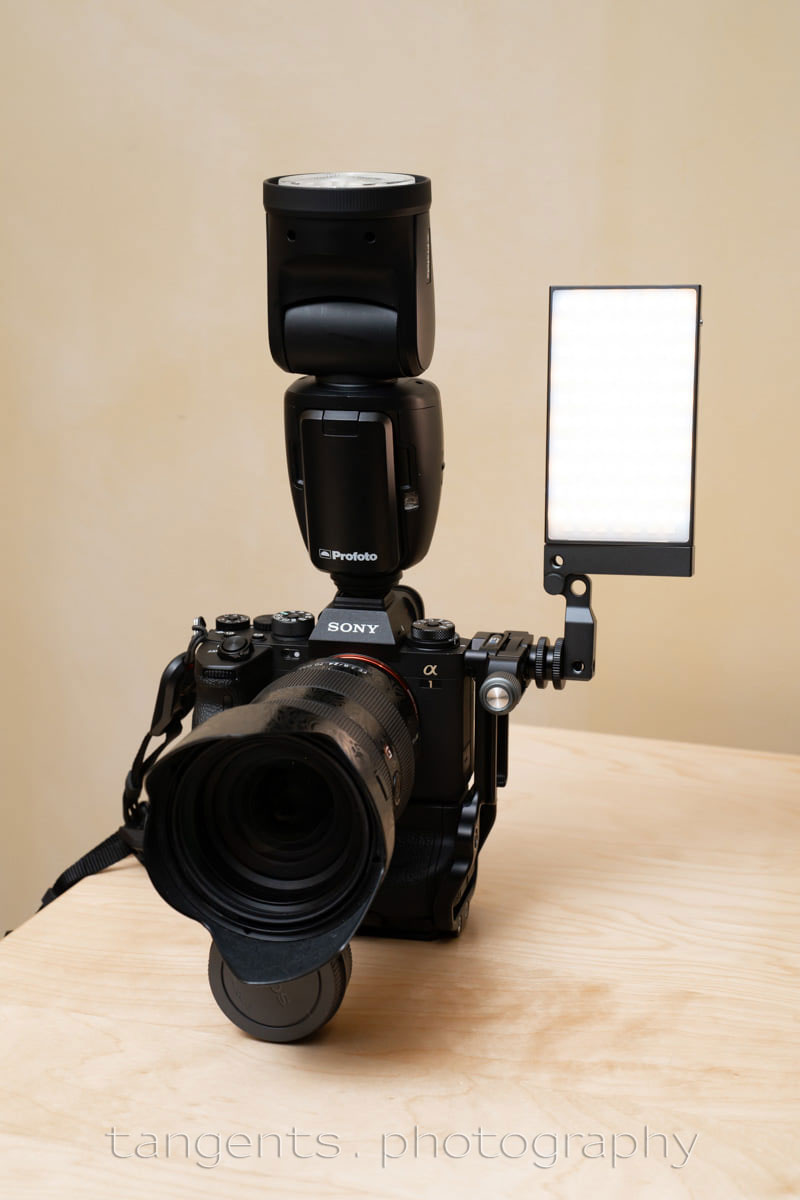
Finding a solution for poor low-light auto-focus with mirrorless cameras
As much as I love all the advantages mirrorless cameras offer, at this point there is still a serious flaw in my experience – the low-light autofocus response just isn’t as solid as the top-end DSLRs. The autofocus capabilities of my Sony A1 (Amazon / B&H) as amazing as it is in proper light, just isn’t a match for my Nikon D5 when it comes to low light levels with low contrast. As the current technology is, mirrorless cameras have a hard time seeing the AF-assist beam from an on-camera flash.
For example, when photographing candid groups of guests at an event, where their backs are to the light source – ie, their faces were shrouded in shadow – the mirrorless camera generally battles.
The solution – adding additional light when needed so the camera can focus. I bought an Arca-Swiss clamp (Amazon) to fit on the Kirk L-bracket (B&H)… and then this slim Godox M1 video light (Amazon / B&H) is fixed onto that Arca-Swiss clamp. I used the L-bracket specifically made for the Sony A1 with the grip, but if you want to try this – adding a video light to your camera – then any L-bracket appropriate to your camera would work.
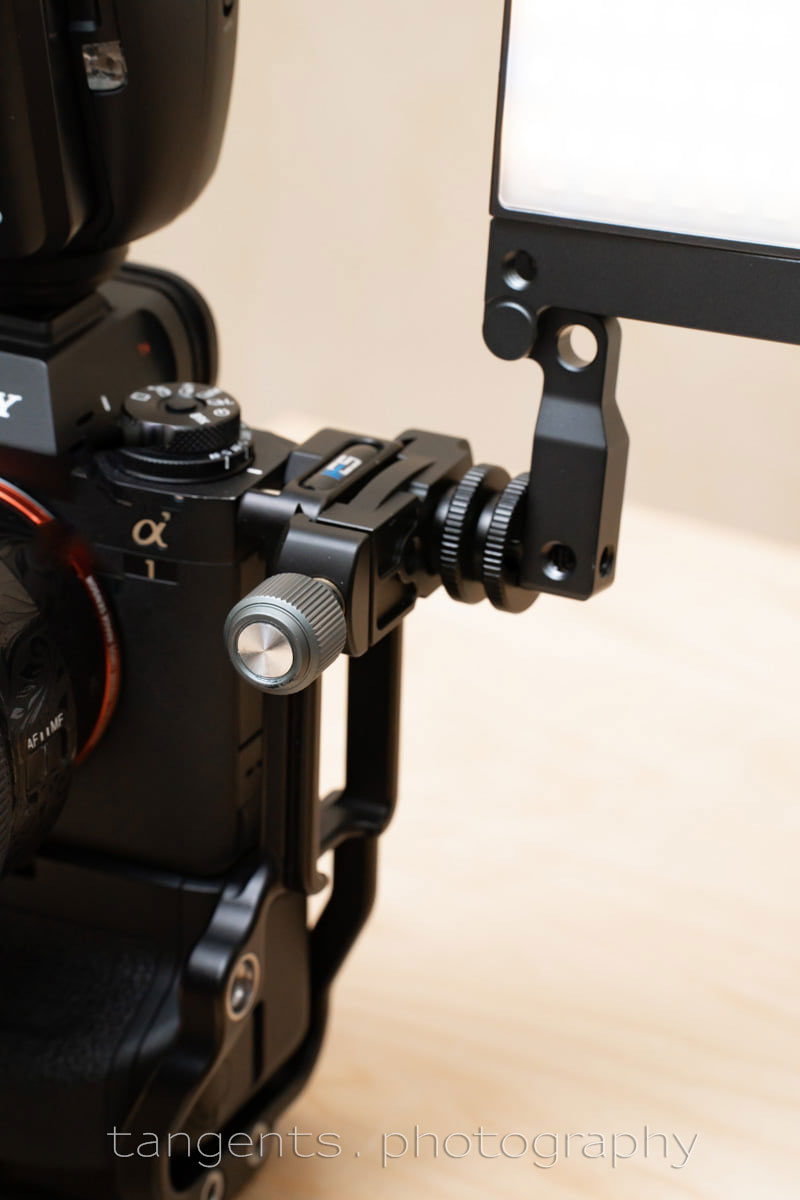
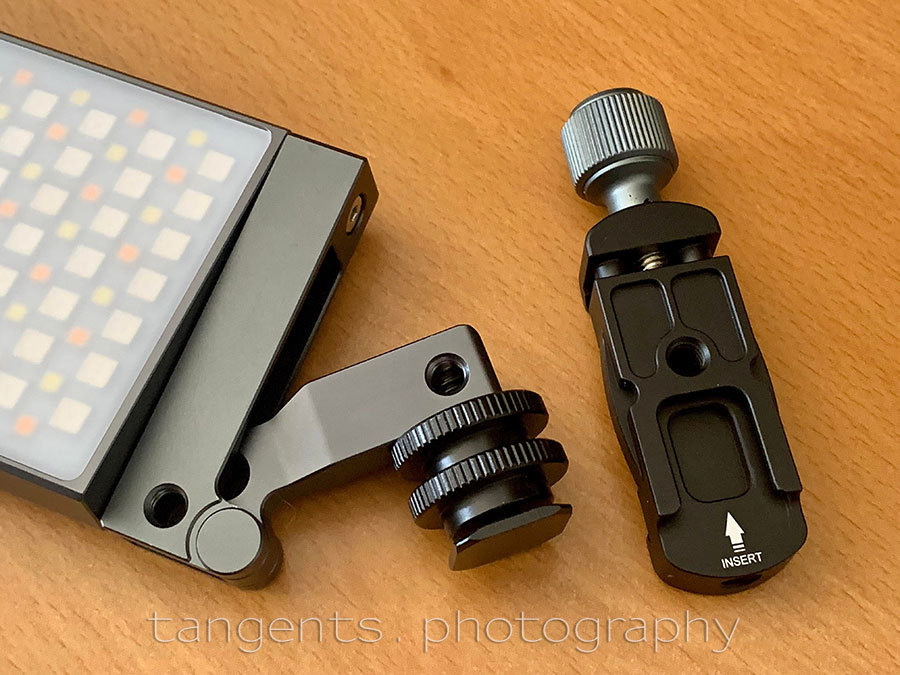
I had been playing with this idea a while now, but just never found the right video light. But when I saw how the Godox M1 video light (Amazon / B&H) hinges in and out, I knew I could make the setup work. The video light is small enough to keep in my camera bag as a matter of course. So it will see other use as well, like photographing details.
Now here’s the thing – the flash AF assist with mirrorless is kinda iffy. Kinda works, kinda struggles. But you will get mirrorless / Sony / Canon / whatever fanboys tell you that their mirrorless cameras focus terrifically in low light. But you can’t just blanket trust their observations, since we don’t know what lighting conditions they are shooting under.
Here are two examples of the kinds of lighting you might encounter at wedding venues – and it is this kind of low-contrast weird light where the mirrorless cameras struggle in my experience. But with this new somewhat clumsy setup, I would be ready.
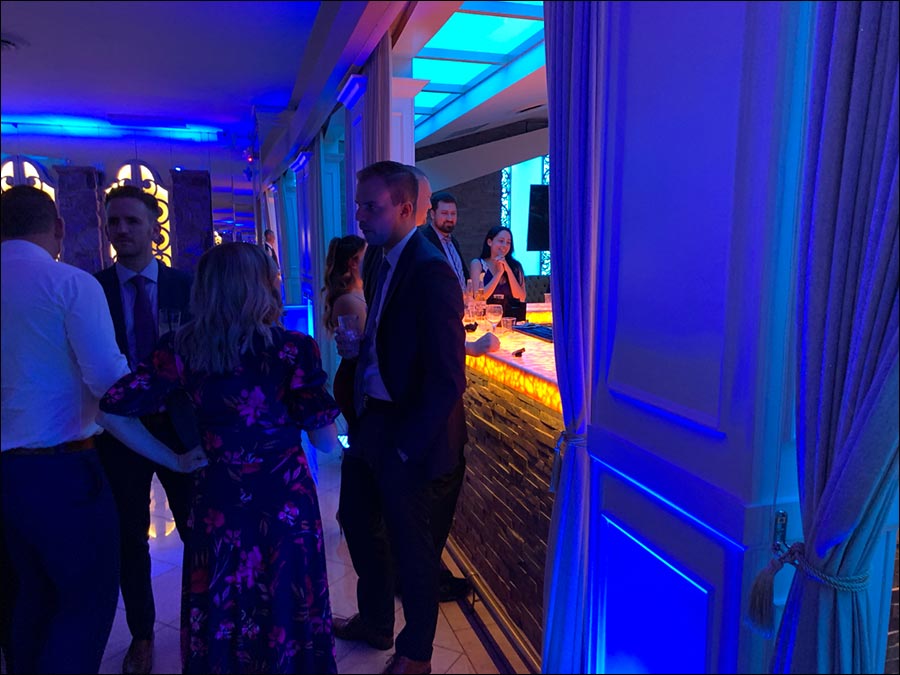
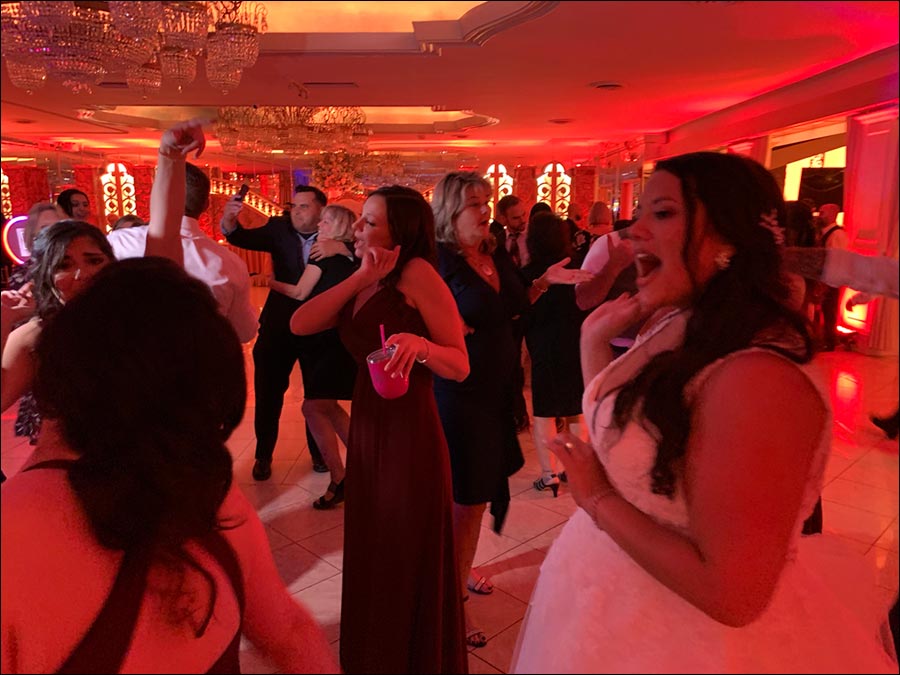
What about the AF assist beam on the Profoto A1 series of flashes? Unless I’ve just convinced myself, turning it on manually via the menu so it’s always on seems to work well in dim lighting at weddings with my Z9.
Any thoughts on this?
Somehow the Sony cameras I use (A9 / A9ii / A1) don’t appear to latch onto that Auto Focus pattern of the Profoto A series flashes as easily as the Nikon D5 did. So they really do better with the constant light from the small video light.
Do you mean the Model light? As the AF assist doesn’t work on Nikon Mirrorless with the A1?
James are you in AF-S or AF-C mode?
Thanks for addressing this, Neil! I shoot a lot of wedding/event photography and struggle with the same exact issue. As much as I love the Z9, the D5 (in conjunction with the flash’s IR AF Assist beam) just snaps right into focus on a dark dance floor or moonlit midnight exit. The Z9 simply struggles in these situations. So I bought a Flashpoint Zoom Li-On III flash (made by Godox). It has a small LCD light on the front that was presumably designed for “hybrid” shooters who might occasionally need a little constant light-source for video. When it’s time for the dark dance-floor shots, I just turn that on (dialed down low so I don’t blind my subjects), and it really increases my keeper rate!
This is interesting to hear. I thought the z9 had some new tech that made it better than other mirrorless for AF.
Chrism, if you use the Nikon Z9, please consider employing Star mode to find focus, unfortunately it does not give you “proper” exposure as well, you will still have to use your knowledge to raise your flash/ISO or lower your SS.
You can map out a button to activate Star mode if you find it useful (I did).
Currently, the vast majority of electronic speedlights have AF assist beams that use patterns of deep red light. Most mirrorless cameras turn the speedlight AF light off, however even if they didn’t, the camera would still not be able to focus in low light because mirrorless cameras (at leas Nikon) have their AF sensors located on Blue and Green photosites, which are insensitive to red light.
If you use a green lamp to illuminate the subject my Nikon Z6II and probably most mirrorless will focus flawlessly in dim light.
Recently Neil you posted a blog on Facebook,about using 2 A1 Profoto lights on your Sony camera. I would like to know how does this 2 lights concept works? Also what is the name of the bracket used to support the second A1 flash? Thanks
Hi there David — I have now written it as a proper blog post here, with the necessary links:
https://neilvn.com/tangents/huge-venues-and-bounce-flash-how-to-double-your-flash-power/
I would love to hear what setup you use for green light to focus in low-light situations! I have Z7II and Profoto A1 flashes and bascially cannot focus with the mirrorless once the lights go off on the dance floor. Help would be appreciated.
Green light? How do you mean? This video light takes care of low light levels or any situation where the mirrorless camera struggles.
Where did you get this information from? Are you telling me a multi thousand dollar camera cannot focus on a red apple? A red dress? Pair of red shoes?
Don – read it in context. We are talking about low light levels. Look at the two example situations I posted. These are real-world situations where the camera struggled.
I am replying it to the guy who said mirrorless can’t focus on red light above, my iphone will focus fine on af assist grid from sb-5000,It is weird that flasgship camera cannot. it would be really nice to know if camera manufacturers clarify why they don’t enable the af grid.. apparently I’ve heard some godox v1 models enable it now with Sony cameras and it works fine. So I don’t know why they disabled it in the first place.
Hi,
i work a lot in events, specially in really dark locations like techno clubs. Earlier this year, I’ve bought the Z 8 and was surprised where is my essential AF assist light gone. Well, I have been warned by Nikon Professional Service, it won’t work because of the IR-fiter used by mirrorless cameras, but I couldn’t believe it.
After 300.000 shots I think I could judge this new hyped Z 8. Great at day, crap at night – unless you got enough light at night to focus. Compared to my D850, it is just useless in some situations in event photography. So finally I always have to take two cameras at my event jobs – rather my old D850.
Here’s the quote from 2018, i found on dpreview.com – “If mirrorless cameras are going to displace DSLRs for wedding and event photography, manufacturers need to find a way”.
I don’t know when the the first mirrorless cameras hit the market, but I’m surprised none of the big companies or accessory companies have build a solution yet…
indeed! And each time are more manufacturers selling flashes. They don’t know what’s happening?
Since you have both type of cameras, have you tried testing toggling af assist beam of d850 and trying to focus on it with z8?
I mean can’t the z8 focus on the red light? Instead of trying to focus on a ir beam??
How are your experiences with this setup? Does it confuse the TTL-metering?
TTL metering appears unaffected. The video light is low enough that it doesn’t substantially add to the final exposure which is nearly all flash.
Ciao a tutti, ultimo aggiornamento Profoto V10, pare che abbiano attivato Laser Focus Assist, dopo 2 anni di collaborazione con Nikon (pensavo bastasse cambiare il colore della griglia, evidentemente no)
Attualmente va solo con Z9 e firm 5.0 .. qualcuno l’ha provato? finalmente abbiamo la soluzione ?? Dovrebbe andare anche aggiornando V1 da quello che leggevo. Grazie
“Hello everyone, latest Profoto V10 update, it seems that they have activated Laser Focus Assist, after 2 years of collaboration with Nikon (I thought it was enough to change the color of the grid, evidently not)
Currently it only goes with Z9 and firm 5.0.. has anyone tried it? we finally have the solution?? It should also go by updating V1 from what I read. Thank you”
Manuel — I would have to do some experimenting in low light. My take is that it appears the mirrorless cameras are not as great reading the projected light from the flash. Part of the problem is that there is no specific data on the problem — it’s anecdotal observations. So that makes it more difficult to make a specific conclusion on this.
What aperture are you using? Also, is the live settings and metering preview enabled? When I’ve had issues with AF in low light, turning the live preview off, prevented the camera from stopping down the lens for the exposure preview and all of a sudden the AF started grabbing focus appropriately.
I’m always around f/4 to f/2.8 … but usually a touch wider than f/4
The flash on the camera disables the Exposure Preview anyway.
Oh and Mirrorless cameras do not exclusively use the sensor for Autofocusing, they do have phase detect as well as contrast detect on most cameras and that’s essentially what the DSLR is using.
Glad I stumbled upon this article as I’m having focusing issues in venues with neon pink/blue lighting conditions just like this with dark ceilings. Not using a mirrorless though. Just an old fashioned guy still using the 5D Mark III, but I have a Profoto Air Remote in the hotshoe with a Profoto B10 (bounce only, no modifier) on a flat base light stand for easy maneuverability as I run around. I find I miss focus a lot, but I think that’s because there’s no focus assist light as if I had an actual Profoto flash in the hotshoe. Do you still use this video LED or have you found something better since this was written? Or would any small LED work to just help out the f2.8 lens/camera?
Yup, I still do the same. Some events, they turn down the lights so dark, that autofocus would be impossible without some kind of assist.
Thanks so much! You are the G.O.A.T. as the people say!